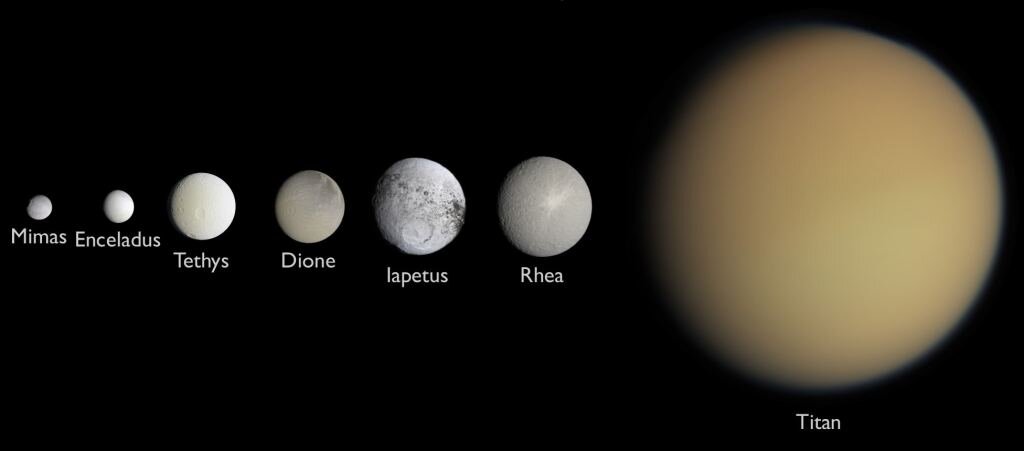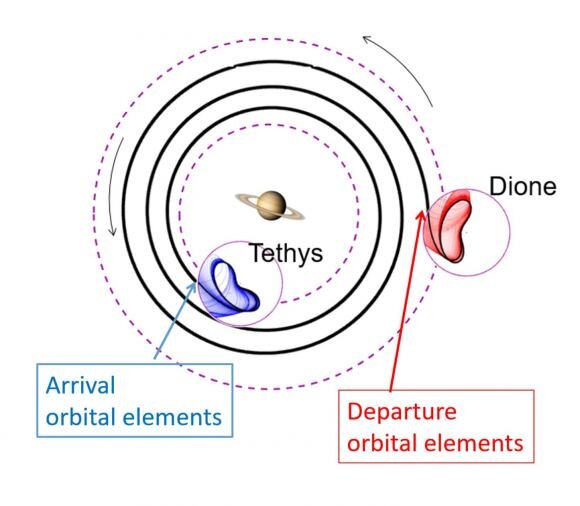Saturn is very far away from us and has many interesting moons, which are not so easy for spacecraft to reach. Recently, scientists have been able to prove that only one automatic probe will be able to fly around them all if it uses an electric motor and a set of very unusual orbits.

Problem of flying to distant planets
In a recently published study, scientists have proposed a way for just one spacecraft to fly around all seven of Saturn’s large moons. Previously, this was considered impossible due to the huge fuel consumption.
Interplanetary flights are actually a transition between two types of orbits: elliptical and parabolic. In the simplest case, an apparatus orbiting a single body, such as the Earth, increases its speed, switches to a parabolic trajectory, reaches the target and reduces its speed relative to it until it is again in an orbit similar to a circle or oval.
However, in the case of distant planets, the flight along a parabolic trajectory is very long. And in order to get there quickly, it is necessary to spend significantly more fuel on acceleration. In addition, we should not forget about the braking at the end, which also needs to be spent.
Usually now this problem is solved with the help of gravitational maneuvers near the Earth, Moon, Mars or Venus. They allow it to accelerate without wasting fuel, but the flight in this case still takes many years.
Saturn’s Moons
In the case of Saturn’s moons, everything is even more complicated. They are small, which means that the surrounding orbit requires very low speed. Earlier, during the Cassini mission, scientists believed that only Titan, the largest of the moons, was so important that it would first accelerate and then slow down the spacecraft.
Now it turns out that at least Enceladus deserves attention. Geysers gushing out of it show the presence of liquid water under the surface of the ocean. Therefore, scientists would like to visit both it and Titan because interest in it does not disappear.
Therefore, modern research projects of the planet’s moons with rings, such as Enceladus Orbilander, are trying to provide for the exploration of both moons. However, they do not do it very well. After all, for this, the spacecraft first needs to gain speed for the flight, then slow down, then accelerate again, and in the end, slow down again.
Flying in complex orbits
That is why other, more exotic flight scenarios are being explored. First of all, they were convinced that electric jet engines should be used for this purpose. They give significantly less acceleration, but allow to keep it for months, accelerating extremely efficiently.

The possibility of using them to fly from one celestial body to another was proved several years ago during the Dawn mission. Then it was possible to reach the orbit of Vesta from the orbit of Ceres. In addition, the slow change in the trajectory of the flight with an electric motor suggested to scientists the possibility of how to explore not one or two moons of Saturn, but at least all seven large ones.
In fact, Enceladus, Dione, Tethys and Mimas do not rotate at such a great distance from each other. And in nature, in addition to the usual ones, there are so-called Lissajous orbits. They arise when three bodies interact, for example Saturn and its two moons.
In this case, they have Lagrange points in which the gravitational forces of all three bodies are balanced. And there are quasi-stable orbits of Lissajous around them. In a system connected to the Earth and the Moon, space telescopes including James Webb fly exactly like this.
However, in the case of Saturn’s moons, these orbits will change dynamically. However, in combination with the usual ones, experts suggest using them in order to move from one moon to another with the least cost.
This is a very promising project, but it has one feature. These calculations are much more complicated than what has been used so far. The three-body problem is not solved in a general way. Each specific maneuver will have to be calculated separately by numerical methods.
However, researchers are still extremely optimistic. After all, compared to everything that has been done in the Saturn system so far, this is really a step into the future, which allows us to study in detail the mysterious worlds orbiting the planet with rings.
According to phys.org
Follow us on Twitter to get the most interesting space news in time
https://twitter.com/ust_magazine
